The report on the income of Austria’s 3.7 million employees, carried out by the Court of Audit (Rechnungshof, RH) in 2004, finds that only civil servants earn more than four years ago. The wages of male civil servants after
deduction of income tax and social insurance
contribution increased by 8.3%, whereas women in the public sector
earn only 0.3% more as compared to 2000.
Both blue- and
white-collar workers experienced income losses
in real terms and also after deduction of income tax and social insurance contribution since 2000. The
median salary of female blue-collar workers after deductions
decreased by 11.1%. As for white-collar employees, men’s pay dropped
by 5.8% and women’s pay
by 1.8%.



